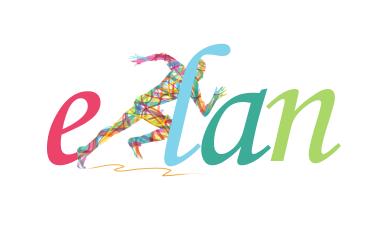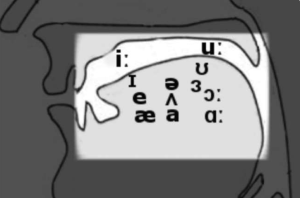Many of my students have problems with pronouncing the English vowels, and sometimes, it’s not much that they can’t pronounce them, but rather, it’s that they can’t tell the difference between 2 vowels that may sound close or similar. They may really struggle with distinguishing between minimal pairs such as ‘ship’ and ‘sheep’, ‘walk’ and ‘work’, ‘put’ and ‘putt’, ‘who’d’ and ‘hood’ etc.
Now, whether you want to speak English clearly or understand it easily, you’ve got to study the vowels, so let me teach you how vowels work and what the tongue and mouth are doing or should be doing.
Look at the picture. This diagram of the mouth shows 12 ‘simple’ vowels (out of 17) and their locations or positions during speech production. Although, in phonetics, the 12 vowels are called monophthongs, I will simply refer to them as ‘simple’ vowels in this article. , but I’m only going to show you 12 of 17 – I call the 12 vowels as the simple vowels. In phonetics, they’re actually called monothongs (pronounced as /ˈmɑnəθɑŋz/).
You can break down the 12 vowels into 5 groups: the vowels that are at the back of the mouth (back vowels), the vowels that are at the front of the mouth (front vowels), the vowels that are positioned high in the mouth (high vowels), the vowels that are positioned low in the mouth (low vowels), and finally the ones that are around the centre (central vowels). Now, when we say the vowels are at the back of the mouth, what we mean is that the tongue is moving back, and when we talk about the vowels that are at the front, what we mean is that the tongue is moving towards the front area of the mouth. If the vowels are positioned high in the mouth, we’re basically saying that the tongue is going up closer to the roof of the mouth, and if the vowels are positioned low, we’re saying the tongue is going down and resting on the surface. Here’s some very important information for you: When you move your lips forward, your tongue automatically moves in the opposite direction; meaning, it moves back. When your lips spread out, as in a smile, you tongue moves to the front. When you open your jaw, your tongue stays at the bottom, and when you close your jaw, your tongue goes up closer to the roof of your mouth. Now, here’s the most useful piece of information for you: most of the vowels we produce are either in the centre or around the centre of mouth. Of the 12 ‘simple’ vowels, there are 5 tense vowels which, as you can see, are located out in the edges:
-
- /i:/ the ‘frontest and highest’, as in the word ‘beat’
- /u:/ the ‘backest’ and highest’ as in the word ‘boot’
- /ae/ the frontest and lowest’ as in the word ‘bat’
- /ɑː/ and /ɔː/ the backest and lowest as in the word ‘bought’ .
Now, because these 4-5 vowels are tense, if you watch an English speaker’s mouth, you’ll clearly see some movement especially with the lips and jaw, whereas, with the other vowels, because they are around the centre, you won’t notice too much movement happening with the lips or jaw. So, ‘bit’ and ‘bed’ may sound similar, as may ‘put’ and ‘putt’. When we speak naturally and quickly, we try to stay in and around the centre, which is the reason why the schwa sound, the vowel right in the centre, is by far the most common vowel in the English language. That is why native speakers can speak fast without moving their lips too much! It is because, when possible, they try to shorten or reduce the length of the vowels.
You may watch the YouTube video below and other videos whose links are in the comments section of the video.


Leave a Reply